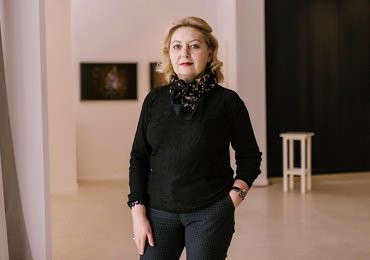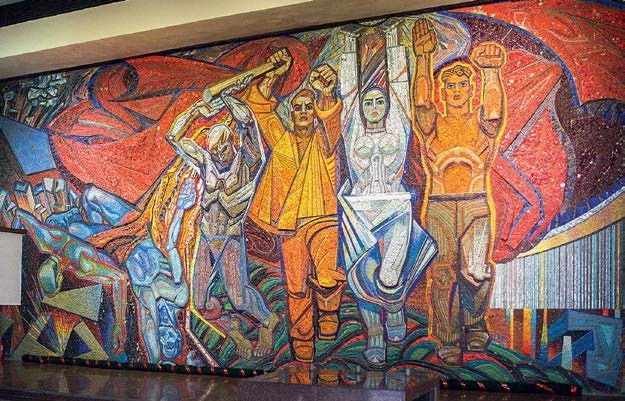
Galyna Sklyarenko: "My audience – reading, thinking public"
2018

We continue to present the books of the publishing series "Ukrainian Art XX-XXI" developed by the foundations Brovdi Art and Abramovych.Art. To your attention, there is a publication of the portal CHERNOZEM (in the original language).
During Book Arsenal, it was presented a new book by a leading art critic, curator of numerous projects, writer Galyna Sklyarenko – "Ukrainian Artists: From the Khrushchev Thaw till the Independence Time". The book was published with the support of the publishing house ArtHuss, Brovdi Art Foundation and ABRAMOVYCH.ART. We asked Galyna about her new book as well as about the art of the period of the second half of the 20th century.
 Galyna Sklyarenko
Galyna Sklyarenko
Galyna, your new book is titled "Ukrainian Artists: From the Khrushchev Thaw till the Independence Time". Why is this period interesting to you?
I have been working on this topic for a long time. It would seem that the 1960-1980s period is our recent past, but it happened that in the history of the Ukrainian art these post-Soviet decades are the least studied, moreover – almost undescribed. There are no monographs about numerous significant, bright and interesting artists, and those written in the Soviet times are often to be rethought. Moreover, this era had its own dynamics and features, its complicated art. Today, this experience is especially relevant. And not only for our history. After all, the so-called "decommunization" is not to replace some monuments with others, but primarily in analysing, researching the Soviet past, its culture and art. In addition, today the artists, who started their creative career in the Soviet era, are still alive, their art is a living part of our culture.

Tell me, please, why this period is interesting to contemporary artists?
First of all, the need for such a long and very important period of art history is quite obvious. In addition, unlike science, where new discoveries and knowledge cancel out the previous ones, artistic talents do not disappear. Moreover, over time they acquire some additional meanings… In the second half of the 20th century, there were wonderful masters, whose work was of great interest. Their experience is important today, both creative and personal. Discovering the wonderful destinies of older artists, one can know just fantastic life stories, when, despite all the ups and downs, the seemingly hopeless circumstances, a person continued to work, create, live brightly and fully, rediscover the power of human spirit and power of talent that can overcome everything in the world. In my opinion, this experience is very inspiring…. After all, in our country, it has always been difficult to be an artist, in each period in its own way. And, nevertheless, art did not disappear, it arose and developed against the circumstances…
 T. Yablonska 'Before The Start', 1947
T. Yablonska 'Before The Start', 1947
What was most important for you to show in this book?
In short, it is the diversity of Soviet art. I wanted to shift the rooted accents, to show "another" art history, with other characters and works. Moreover, to reveal the relationship of art with the historical context, especially important for the late Soviet period. After all, it was a special culture, with its own ideas about modernity and art. Working on this book, I became convinced once again that the art of this period did not fit into clear chronological stages, different from European trends. Within the interpretation of this period, it seems to me productive the idea of the Moscow art critic A. Yerofieiev about the "art of individual mythologies", when every thinking artist himself "constructed" his own versions of art, often quite different from what was happening in the world. It is interesting that at that time "modernity" did not play a big role for numerous people, other intentions were important: return to art, desire for freedom, desire to restore broken links with traditions…
 S. Pustovoit 'Restorers', 1973-1974
S. Pustovoit 'Restorers', 1973-1974
How to identify your readers?
First of all, these are people who are interested in art. These are people who are interested in history. These are people who are interested in our culture and country. Probably, this is a reading and thinking audience, those who go to exhibitions, museums… I hope that the book will be interesting to art historians, artists, critics, students of art schools.
 A. Horska, V. Zaretskyi, V. Smyrnova with the participation of B. Plaksii and A. Lymariev. Mosaic panel "Flag Of Victory", Krasnodon, 1968-1970 (photo by Y. Nikiforov)
A. Horska, V. Zaretskyi, V. Smyrnova with the participation of B. Plaksii and A. Lymariev. Mosaic panel "Flag Of Victory", Krasnodon, 1968-1970 (photo by Y. Nikiforov)
What did you rely on when working with the book?
Every art study begins with an analysis of the works of predecessors – books, monographs, articles. In this case, there is too small information about numerous artists mentioned in my book. That's why I tried to use home archives, memoirs of contemporaries and author's texts. I spent several months at the Museum-Archive of Literature and Art, I worked on the archive of the Union of Artists and I found a lot of curious… Personal archives of artists are of great value. For example, a hand-written autobiography (not yet finished) of Florian Yuriev. It’s so fascinating that it could be a novel. I quote it in the article about this remarkable artist…
 M. Hrytsiuk 'A Violinist. A Portrait of Gidon Kremer', 1977
M. Hrytsiuk 'A Violinist. A Portrait of Gidon Kremer', 1977
Why do people need art?
Art is a very complex thing, requiring intellectual, emotional, spiritual work. This is probably not for everyone, and not everyone can make such mental efforts. But for those who want to understand the world and themselves in it, for those whose soul yearns for discoveries, knowledge, new emotional experience, art is necessary. Everybody can find what he needs, the one with whom he will never get bored. Art provides an opportunity to understand a lot of things. In particular, in order to understand Ukraine, it’s enough to closely see the works at the National Art Museum and a thoughtful, sensitive viewer will see everything: strength, weakness, emptiness, and cracks… He will understand everything. Because art is about people. Everything that is in a person’s heart, is in the art as well. The more you see, the more you understand, the more you analyse, the more you understand the country, people, and finally yourself. If, of course, you want… The main thing – do not force anyone to do this. Art is voluntary.
Images from the book are provided by the author
© chernozem.info
Stay up to date with art events, subscribe
